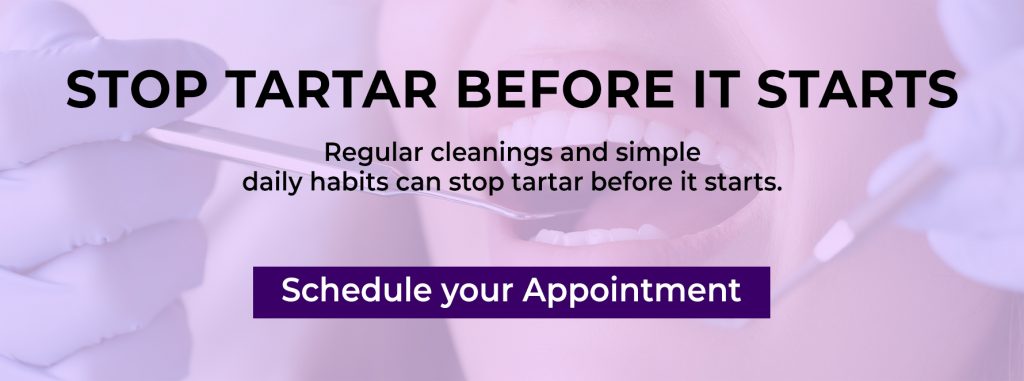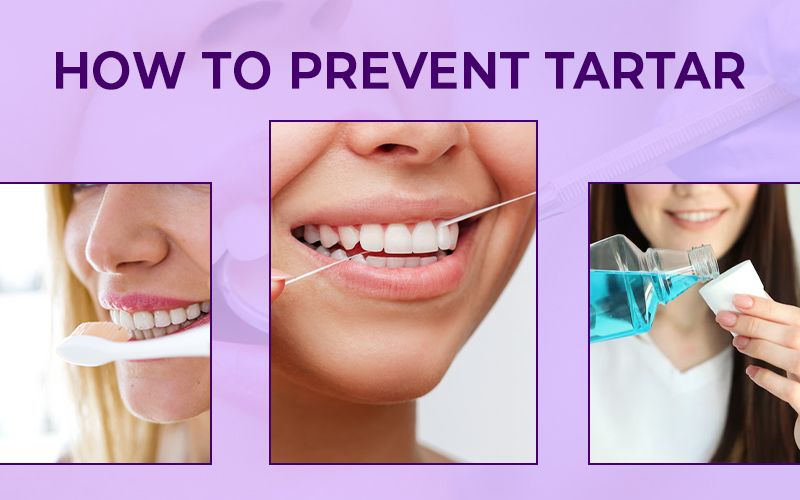What Is Tartar?
Tartar on teeth, in contrast to plaque, adheres firmly to the enamel and is not removable with routine brushing or flossing. It makes the surface abrasive, which attracts more bacteria and raises the risk of gum disease, cavities, and foul breath. Tartar also causes noticeable staining and dullness of the teeth. It can only be securely removed during a cleaning by a dentist.
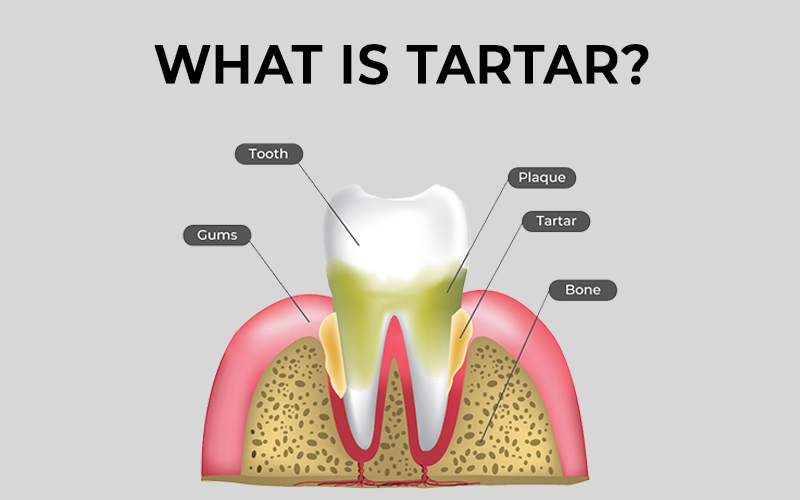
What Is Tartar Made Of & What Does Tartar Look Like
- Composition: Mineral-rich deposits like calcium phosphate, calcium carbonate, and magnesium phosphate combined with dead bacteria and proteins.
- Color & Texture: Begins pale yellow or off-white and darkens to brown, gray, or black, especially under the gums. Black tartar on teeth often results from staining agents like coffee, tea, or tobacco, or from mixing with blood.
Symptoms, Smell & Risks of Tartar
- Visual Signs: Hard, crust-like coating on teeth, often yellow or darkened.
- Sensation: When you run your tongue over your teeth, they could feel fuzzy or scratchy.
- Odor: Tartar harbors bacteria that cause persistent bad breath (halitosis).
- Complications: Leads to gingivitis (gums that are red, swollen, or bleed), advanced gum disease, cavities, gum recession, and even bone loss.
What Causes Mouth Tartar & Risk Factors
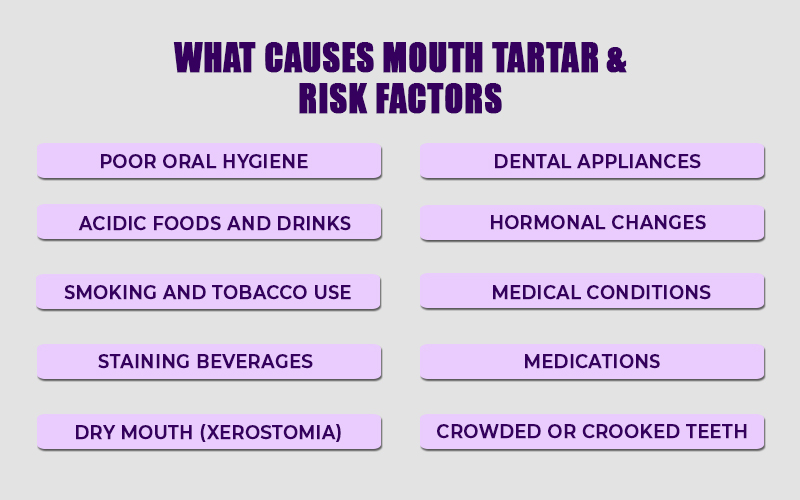
- Poor oral hygiene: Plaque can accumulate and solidify into tartar when brushing and flossing are done infrequently or incorrectly.
- Diet: Frequent consumption of sugary or starchy foods feeds harmful bacteria that produce plaque.
- Acidic foods and drinks: Acidic products like vinegar, soda, and citrus fruits can weaken tooth enamel, making it easier for tartar to form more quickly.
- Smoking and tobacco use: Tobacco not only stains teeth but also reduces saliva flow and encourages tartar formation.
- Staining beverages: Coffee, tea, red wine, and cola can lead to both plaque and dark tartar deposits.
- Dry mouth (xerostomia): With less saliva to wash away bacteria, plaque sticks more easily to teeth. If not cleaned, this plaque hardens into tartar, making it harder to remove without professional care.
- Crowded or crooked teeth: These areas are harder to clean, (xerostomia): A lack of saliva prevents natural cleansing of the teeth, making them prime spots for tartar accumulation.
- Dental appliances: Braces, retainers, or poorly fitted crowns can trap plaque and make cleaning more difficult.
- Hormonal changes: Pregnancy, puberty, or menopause can increase gum sensitivity and susceptibility to tartar.
- Medical conditions: Certain medical conditions, such as diabetes and autoimmune disorders, can impact your mouth’s ability to fight bacteria, thereby increasing the risk of plaque and tartar buildup.
- Medications: Antihistamines, antidepressants, and blood pressure medications are among the medications that can decrease salivary flow and raise the risk of plaque.
- Genetics: Some people are genetically more prone to excessive plaque and tartar buildup despite good hygiene.
Black Tartar vs. Plague
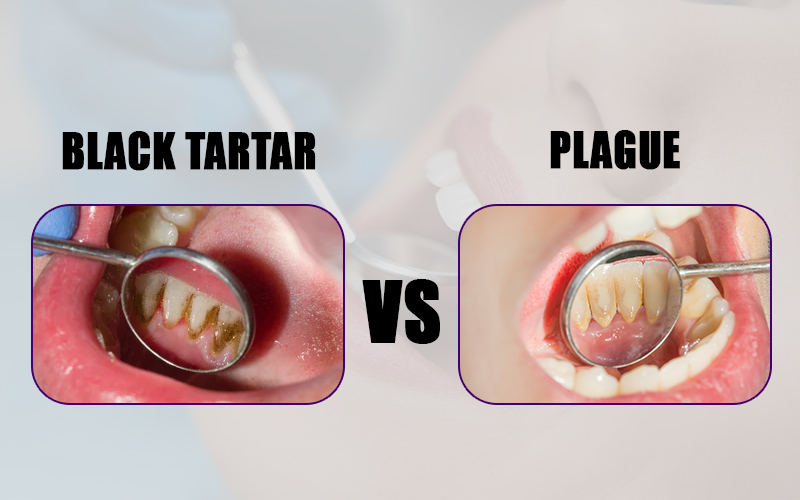
Your teeth and gums are continuously covered in a thin layer of germs called plaque, which can be colorless or pale yellow. It develops when food particles mix with saliva and bacteria, and it can be removed with daily brushing and flossing. Plaque turns into tartar if it is not routinely eliminated.
Black tartar, on the other hand, is a hardened form of plaque (also called dental calculus) that has darkened due to exposure to staining substances like coffee, tea, tobacco, or red wine. It may also appear darker if mixed with blood from inflamed gums. Black tartar often forms below the gum line, making it difficult to detect and more damaging to your oral health.
While plaque is reversible with good hygiene, black tartar is a serious oral health concern that cannot be removed at home. It requires professional tartar removal to prevent complications like gum disease, bad breath, and even tooth loss. To learn more about how plaque compares to tartar, check out our blog: Plaque vs Tartar: Key Differences & Removal Tips.
Diagnosis: How Dentists Identify Tartar
During routine dental checkups, your dentist or hygienist will visually examine your teeth for signs of tartar on teeth, especially around the gum line. Hardened tartar often appears as yellow, brown, or black deposits that can’t be brushed off. To detect tartar buildup below the surface, they may use dental instruments to probe the gum pockets or take dental X-rays to identify hidden deposits under the gum line. These tools help assess whether the tartar is contributing to gum inflammation or bone loss. Early detection is key to preventing more serious oral health issues like periodontitis.
Treatment: Professional Tartar Removal
- Prophylaxis (routine cleaning): Removes tartar above the gum line using scalers and polishers.
- Scaling & root planing (deep cleaning): Targets tartar and bacteria beneath gums and smoothens tooth roots. Often requires local anesthesia and sometimes antibiotics.
- Additional treatments: For advanced gum disease, options include osseous surgery or laser periodontal therapy.
Can You Remove Tartar at Home?
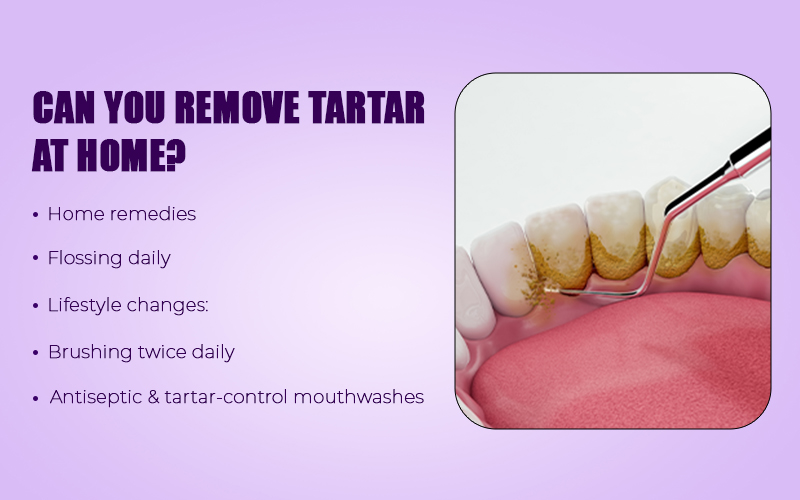
Tartar requires professional removal, but here’s what you can do at home to help prevent and manage tartar buildup and learn how to remove a tartar from teeth before it hardens:
- Brushing twice daily with a fluoride toothpaste for tartar removal helps prevent plaque from hardening.
- Flossing daily or using interdental brushes/water flossers removes plaque between teeth.
- Antiseptic & tartar-control mouthwashes kill remaining bacteria, Listerine Ultraclean reduces buildup by targeting plaque above the gumline.
- Lifestyle changes: Avoid tobacco, minimize staining foods, drink water, chew sugarless gum, and wait 30 minutes after acidic foods before brushing.
- Home remedies (e.g., baking soda, oil pulling) may help slow plaque, but do not effectively remove tartar; you still need professional cleanings.
Prevention: Daily Habits & Tools That Work
| Habit | Why It Works |
|---|---|
| Brush 2×/day for 2 minutes | Removes plaque before calcification |
| Use fluoride tartar-control toothpaste | Strengthens enamel and disrupts plaque formation |
| Floss daily | Reaches between teeth where tartar begins |
| Rinse with antiseptic mouthwash | Kills bacteria in hard-to-reach spots |
| Drink water & chew gum | Stimulates saliva flow, reduces acid |
| Avoid sugar, acid, and tobacco | Reduces staining and bacterial fuel |
| Use an electric toothbrush | Proven to reduce plaque & tartar faster |
Many of these methods, like Listerine mouthwashes, are backed by research showing up to 5× more plaque reduction compared to just flossing.
How Often Should You See Your Dentist?
- Most people should visit the dentist every 6 months for a routine checkup and dental tartar removal.
- Regular cleanings help control tartar on teeth before it leads to gum disease, cavities, or bad breath.
- If you have a history of gum disease, heavy tartar buildup, or bleeding gums, you may need visits every 3, 4 months.
- Individuals with risk factors like smoking, diabetes, orthodontic appliances, or dry mouth may also require more frequent cleanings.
- After evaluating your dental health, your dentist will create a visit schedule that works for you.
- Consistent dental visits are essential for preventing complications and maintaining a healthy, tartar-free smile.
Final Thoughts
In addition to being ugly, tartar on teeth is a primary cause of gum disease, tooth damage, and foul breath. While you can’t remove it at home, you can prevent it from forming with the right routine. Consistent professional cleanings, fluoride-rich products, and smart daily habits are key to keeping your smile clean and healthy. Investing in a tartar-control toolkit can make all the difference in long-term oral health.
Kathy Jacobsen Contemporary Dentistry Tip: Ask us about our personalized “Tartar-Control Starter Kit”, featuring electric toothbrush demos, fluoride toothpaste recommendations, and hydrofloss education at your next visit. We’re here to help you stay ahead of the buildup before it becomes a bigger problem!
Frequently Asked Questions
What causes tartar on teeth?
Plaque not fully removed by brushing or flossing mineralizes into tartar, made of bacteria, minerals, and dead cells.
Does tartar smell bad?
Yes, tartar harbors odor-causing bacteria and food debris, resulting in persistent bad breath.
Can you remove tartar at home?
No. Professional cleaning is required; DIY scraping can damage enamel and gums.
What is black tartar?
It’s stain-laden tartar, often found under the gumline, darkened by stains or blood.
What happens if I don’t remove tartar?
You risk cavities, gum disease (gingivitis, periodontitis), bone loss, loose teeth, and worse breath.
How do dentists treat tartar?
Through scaling and polishing (routine) or scaling and root planing (deep cleaning), sometimes with anesthesia, antibiotics, and possible laser therapy.
How Do You Make Tartar?
Tartar forms when plaque isn’t removed and hardens from minerals in saliva, sticking firmly to teeth.
